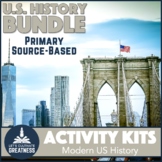WWII Propaganda Posters Activities and Project Print & Digital
- PDF
- Google Apps™

What educators are saying
Also included in
- Step up your 1900s U.S. History units (Great Depression, WWII, & Civil Rights Movements) with these 6 kits, high-interest deep-dives that will intrigue your students with the backstories and primary sources that make studying history so fascinating. Each kit comes in both printable PDF and digiPrice $23.20Original Price $29.00Save $5.80
Description
Examine over a dozen famous WWII home front propaganda posters for the devices used, culminating learning with students creating posters of their own to address a current school problem.
Let your principal decide whose poster has the winning message to transform your school’s culture!
This plug-and-play PBL activity kit comes as a printable PDF and digital in Google Slides!
Greatness is spotting persuasive devices at work and knowing how to use them for good.
World War II was the U.S.’s greatest fight of the 1900s. Though the fighting was “over there,” Americans back home wanted to do their part. And there was so much to do!
The U.S. Government issued countless posters conveying all sorts of messages to an eager and patriotic audience, unsure and unfamiliar with what they could do to support the cause.
Cut through the boring textbook and head straight to the compelling sources that make learning real and immediately relevant, challenging your students to wonder, “How can I effectively persuade the behavior of others?”
Included in this complete WWII Propaganda Poster PBL Kit:
Teacher Materials
- Teacher overview and lesson plans for each activity
- Answer keys and rubrics for all activities
- Instructional slide deck with all image files and analysis questions
Student Activities
- Concept Definition notes to develop a deep understanding of the propaganda
- Propaganda Devices handout of 12 selected devices for a mini-lesson intro
- Matching game activity where students pair devices with modern examples
- Whole-class poster analysis collaborative activity
- Poster analysis gallery walk activity of 16 more posters
- Extended written analysis on one poster with rubrics and template
- Create-your-own poster project with step-by-step directions, planning and reflection questions, 2 sample posters, and rubrics for summative assessment
- Google Slide paperless version of all student materials
What Other Teachers are Saying
⭐⭐⭐⭐⭐ "This is one of the best resources I have ever purchased from TPTo. Highly engaging, lessons are well designed and adaptable, perfectly challenging for all of my students at all levels." - April S.
⭐⭐⭐⭐⭐ "We really enjoyed this activity. In the past I had students create a poster that fit the historic context of the war, but most ended up copying from ones on the internet. Having them use propaganda to spread positive messages was so much more meaningful to them and we had a lot of fun!" - fellow TPT teacher-author
⭐⭐⭐⭐⭐ "WOW! I used this as part of a trimester-long LA/SS unit on WWII. I definitely recommend this resource if you want to include the study of propaganda in your WWII unit!!" - Makena T.
Want more WWII primary source activities?
- Roosevelt & Rockwell Paired Document Writing Activity analyze the inspiration call to action
- WWII Warfront Primary Source 6-Pack explore the difficult decisions facing our political and military leaders in the fight of their lives
Want more engaging U.S. History activity packs?
- Great Depression: empathize with Dust Bowl survivors in 7 activities that analyze photos and personal letters.
- WWII Japanese Internment: empathize with Japanese Americans in 6 activities to analyze photos in order to create their own image.
- Roosevelts & Rockwell's Four Freedoms: dig deeper into the call to action against the growing atrocities overseas in order to connect art to real events.
- Montgomery Bus Boycott: discover the untold story behind the event that started the Civil Rights Movement and challenge students to start their own movement.
- Little Rock Nine: explore the balance of rights and responsibility by getting into the heads of key people involved in this front-page crisis.
This listing is for one license for regular, non-commercial classroom use by a single teacher only. Commercial use like online teaching (ex. Outschool) or sharing with other teachers (ex. shared drive, in a Facebook group, in a professional development training) is strictly prohibited.
By purchasing a license to this resource, you have access to all future updates at no cost, available under “My Purchases." Multiple and transferable licenses are available for purchase. PDF files are uneditable, other files have editing abilities, unless otherwise stated. All files are protected under federal copyright laws.
To request a complete terms of use prior to purchase or if you have any questions about this resource, please leave a question below under Product Q&A.






